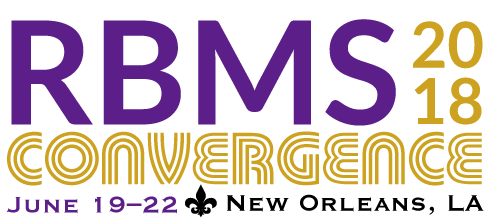Where y’at? New Orleans in Translation
By Elizabeth Joffrion, RBMS Member-at-Large and Local Arrangement Subcommitee Liaison
To enjoy the pleasures of New Orleans, you must love the city for her faults and peculiarities, as well as her virtues and charms. She requires a certain measure of unconditional love to experience her fully. The food, music, and hot, humid weather all contribute to a general feeling of decadence that draws unsuspecting tourists to this unique place every year. Those fortunate enough to be native to New Orleans take pride and pleasure in the ruin and decay of her streets, architecture, and public spaces, and naturally assume “y’all” tourists will, too. As you prepare for your visit, try to set aside any expectations you have about the city, as these illusions of control will certainly diminish the experience that awaits you. Keep in mind that New Orleans has more in common with the Caribbean than it does with the rest of the United States, so as the locals say, just “go with da flow” and let the city reveal herself to you, in her own way.
During its long and complex history, the people of New Orleans have developed a language that is distinctive to the city and reflective of its ethnic and racial origins. If you listen closely, you will hear words and expressions not found in the rest of the United States, including amusing pronunciations of common words that offer a glimpse into the rich cultural gumbo the city. Most first-time visitors are surprised to learn that the local patois is not imbued with a Southern drawl, but is more comparable to voices heard on the streets of Brooklyn or Boston. Like most major cities, the New Orleans dialect varies by neighborhood and most locals can discern whether the speaker hails from Uptown, Mid-city, the 9th Ward, the Irish Channel, or Chalmette. Even the name of the city is pronounced in slightly different ways based on the neighborhood of origin. However, to entirely mispronounce New Orleans is a major faux pas, so to be on the safe side, practice saying “N’Awlins.” The locals will appreciate it, much in the way the French appreciate those who avoid butchering their language.
For those visiting New Orleans for the first time, or even tourists who know the city well, may find it helpful to review a selective glossary of the local parlance along with some tips for enjoying the city. You may notice that much of the local slang remains influenced by the French.
-
- Bayou. (by’you) A slow stream or body of water. To experience a real bayou, travel down Esplanade Ave. to Bayou St. John and City Park. A lovely part of town known as Mid-City.
- Banquette. (ban’ket) A sidewalk. Many locals still use this expression.
- Beignets. (ben’yays) Fried sweet dough with powdered sugar. The best time to get beignets is late at night. Don’t even consider Café du Monde in the morning. Head over to the Moonwalk afterwards to enjoy the Mississippi River in the moonlight..just don’t get mugged.
- Cher. (shahr) Dear or love. Good greeting to use when flirting.
- Dressed. A sandwich served with lettuce, tomato, and mayonnaise. If you order a sandwich in New Orleans, you will be asked if you want it dressed- guaranteed.
- Fais Do Do. (fay dough dough) A late night dance.
- Go Do Do. (go dough dough) Go to sleep.
- Fauberg Marigny and the Bywater. Two of the older neighborhoods outside of the French Quarter where good music can be found. Check out DBA, Snug Harbor, The Spotted Cat, and Vaughn’s.
- Gallery. (gall reeee’) An outside balcony on an upper floor. Good venue for tossing beads and exposing breasts.
- Lagniappe. (lan’yap) Something extra, free, a baker’s dozen. Evidence of local hospitality.
- Lakeside/Riverside. There are no compass directions in New Orleans, as north and south do not exist. Direction is determined by whether the place is oriented to Lake Pontchartrain or the Mississippi River. Sometimes, it is better not to ask.
- Makin Groceries. Shopping for food.
- Muffuletta. (moo fa’ lotta). Large sandwich with cured meats, cheese, and olive mix. One of the best is at Central Grocery on Decatur St.
- My Nez. Mayonnaise
- Neutral Ground. Median or grassy area between lanes on a boulevard. Originally applied to Canal St., the expression reflects the cultural divide between the American (Uptown) and Creole (French Quarter) sections of town.
- Praline. (prah’leen, or praw’leen. never pray’leen) Obscenely sweet candy and a great gift to bring home. The best are found at Loretta’s or Leah’s.
- Sazerac and Pimm’s Cup. Two local cocktails. Try the Sazerac at its namesake bar and the Pimm’s Cup at the Napoleon House.
- Shotgun House. A single house typically containing two dwellings. The rooms are lined up in a single row connected by a side hall.
- Suicide Oaks. Or the dueling oaks. Another stop in City Park with a rich and tragic history.
- Tchoupitoulas Street. (chop a two’ les) For those headed to Tipatina’s you should know how to pronounce the street destination.
- Who Dat? A New Orleans Saint fan.
- Yat. A standard greeting. Where you at? Also, a native New Orleanian.
New Orleans and its people are unique, authentic, eccentric, unruly and a little crazy. But, mostly New Orleans is a survivor. Because of its difficult history, the people of New Orleans believe in “passing a good time” by living mostly in the present. Consider yourself a tourist in another country and by all means enjoy what the city offers you. It will be different every time you visit.
Les bon temps rouler!!!
